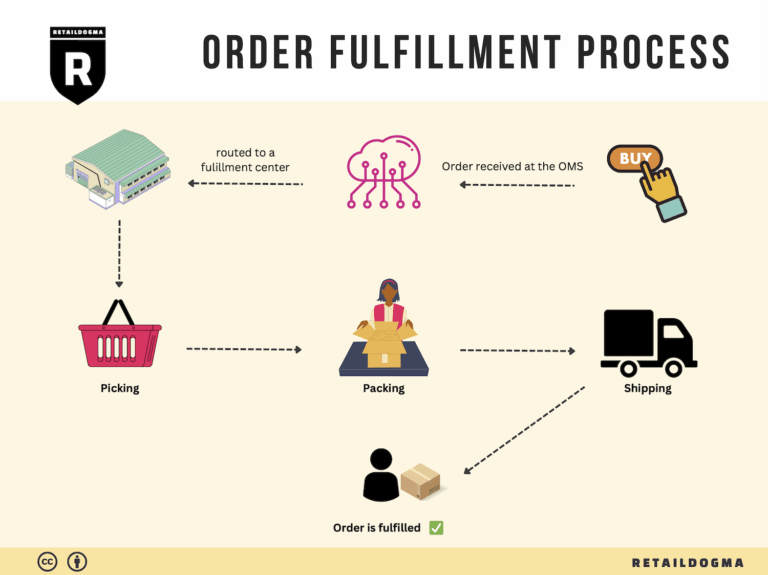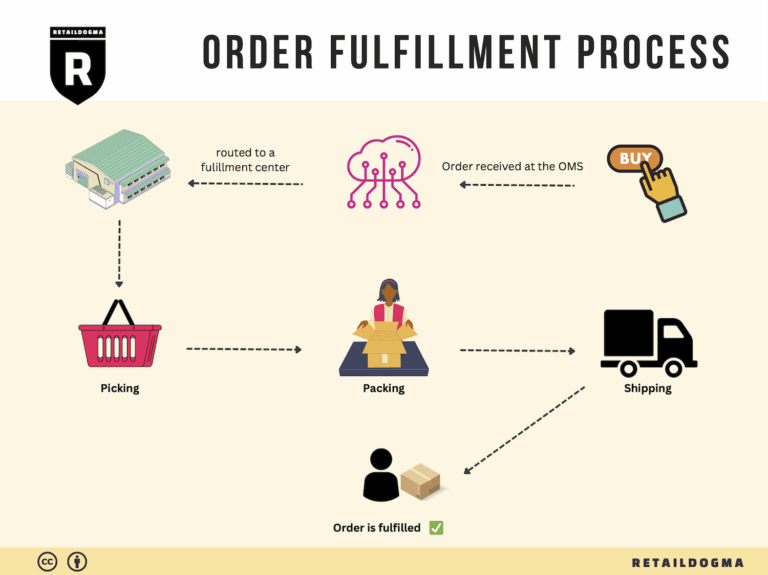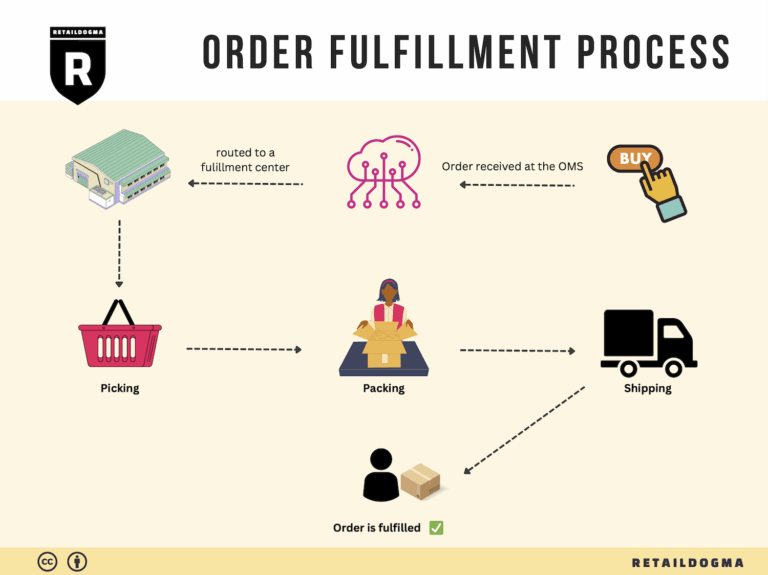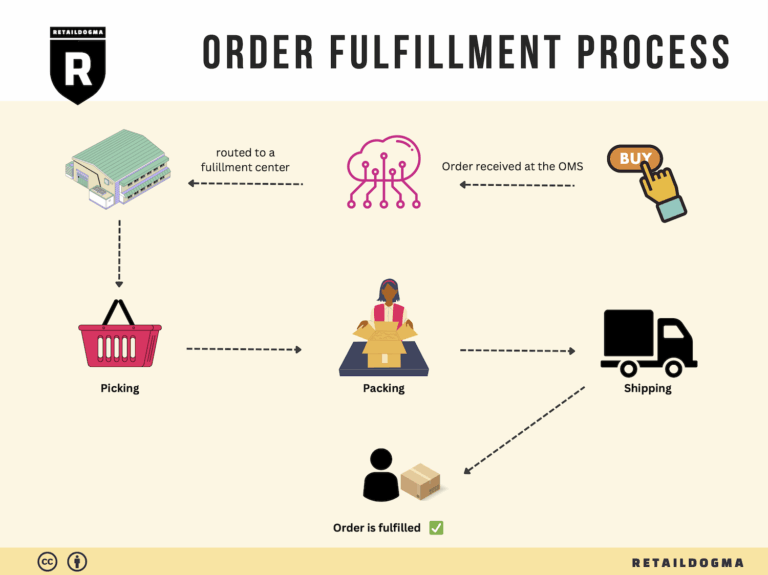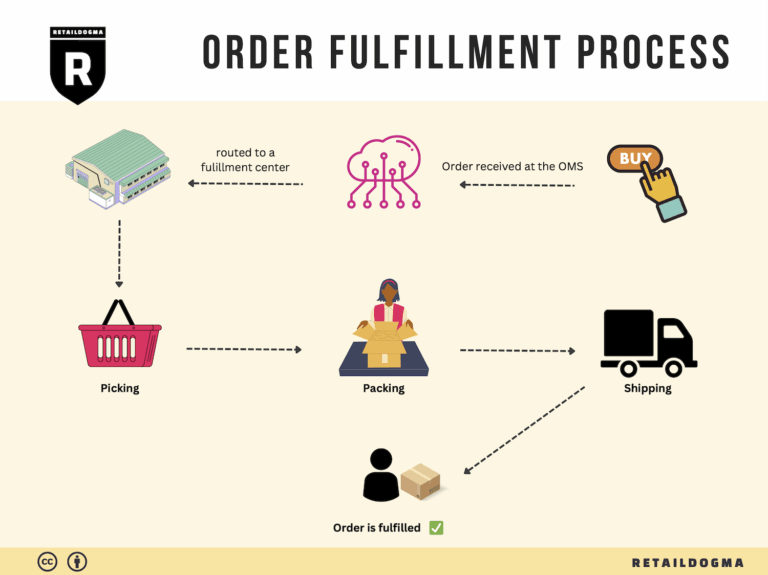What Is A Fulfillment Center? A Complete Guide (2025)
What is E-commerce Fulfillment? An Introduction for Growing Businesses
Understanding E-commerce Fulfillment: A Vital Component for Growth
As your online business begins to flourish, managing the logistics of packing and shipping orders can quickly become overwhelming. The excitement of increased sales often turns into stress when you find yourself buried under boxes, packing materials, and shipping labels. This is where e-commerce fulfillment becomes critical.
E-commerce fulfillment is essentially the process of getting a product from your inventory to the customer’s doorstep. It encompasses a range of activities including order processing, inventory management, packing, shipping, and handling returns. For many growing businesses, navigating these complexities can be daunting, especially when trying to maintain excellent customer service and efficiency.
In this guide, we will explore the various models of e-commerce fulfillment available to businesses today. You’ll learn about Third-Party Logistics (3PL) providers, Fulfillment by Amazon (FBA), and in-house fulfillment strategies. Each model has its own advantages and drawbacks, and understanding these will help you choose the right approach for your business.
We will also delve into the core services that fulfillment partners typically offer. These services include inventory management, order processing, shipping logistics, and returns management. Knowing what to expect from a fulfillment partner will empower you to assess potential providers effectively.
Choosing the right fulfillment partner is a critical decision that can significantly impact your business’s efficiency and customer satisfaction. We will guide you through the key factors to consider when selecting a logistics partner, including their technology capabilities, location, service offerings, and customer support.
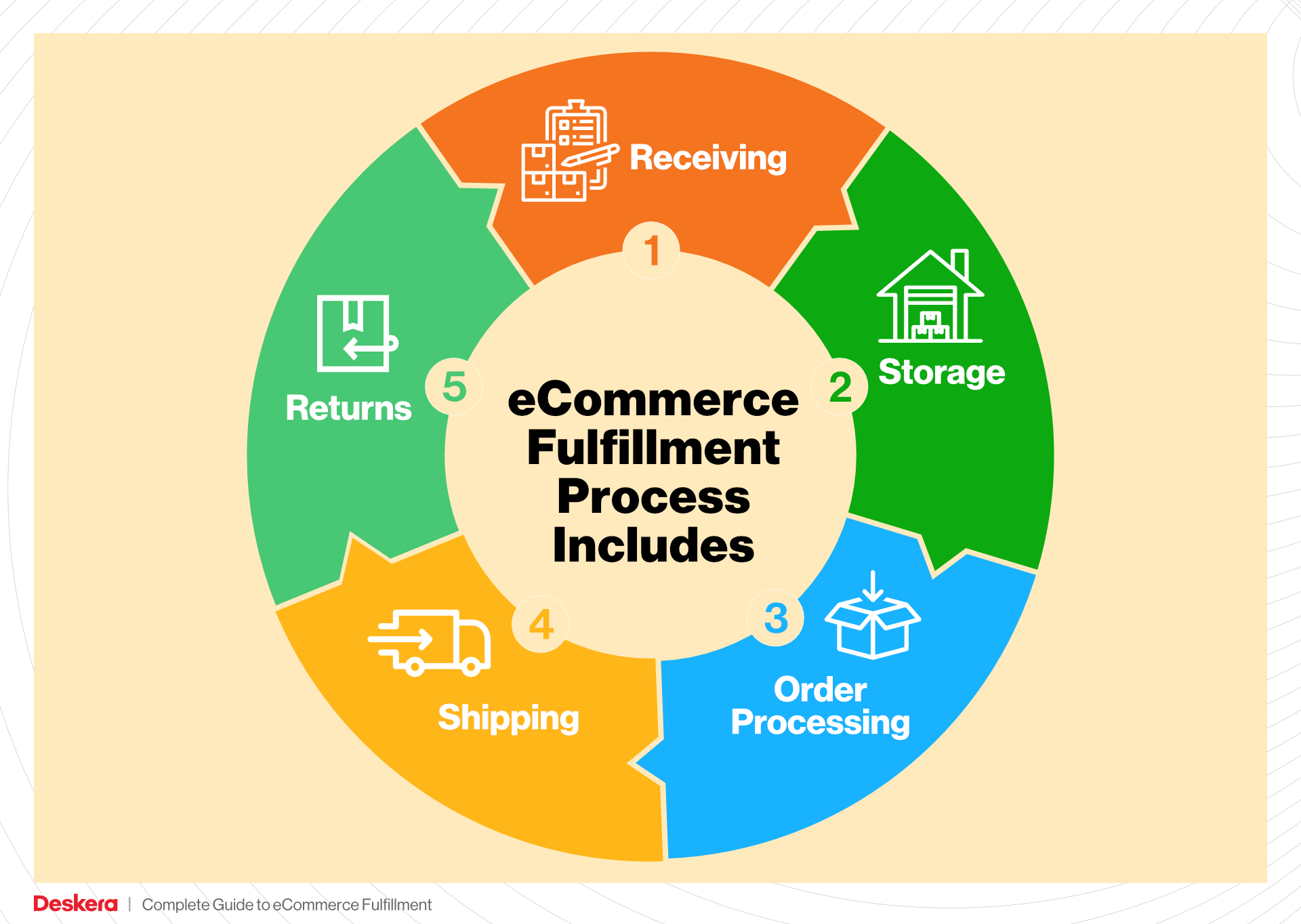
Furthermore, pricing can often be a confusing aspect of fulfillment. We will break down the costs associated with various fulfillment models and provide insights on how to evaluate pricing structures to ensure you’re making a financially sound decision.
The ultimate goal of this guide is to empower you—business owners, operations managers, and entrepreneurs—to make informed choices about your logistics strategies. By understanding the ins and outs of e-commerce fulfillment, you can streamline your operations, enhance customer satisfaction, and position your business for sustainable growth.
What You’ll Learn In This Guide
- What is E-commerce Fulfillment? An Introduction for Growing Businesses
- The Order Fulfillment Process: From ‘Buy’ Button to Customer’s Door
- Comparing Fulfillment Models: In-House vs. 3PL vs. Dropshipping
- A Deep Dive into Amazon FBA: Pros, Cons, and Who It’s For
- Core Services Offered by Fulfillment Centers
- How to Choose a Fulfillment Partner: A 6-Point Checklist
- Understanding Fulfillment Pricing: A Breakdown of Common Fees
- Frequently Asked Questions (FAQs) about Fulfillment
- Conclusion: Is Outsourcing Fulfillment the Right Move for Your Business?
- Important Disclaimer
The Order Fulfillment Process: From ‘Buy’ Button to Customer’s Door
1. Receiving Inventory
The order fulfillment process begins with receiving inventory, where products are delivered to the fulfillment center. Upon arrival, each item is checked against the purchase order to ensure accuracy in quantity and type. This step is crucial because discrepancies at this stage can lead to inventory inaccuracies, resulting in stockouts or overstock situations later on.
Key terms associated with this step include SKU (Stock Keeping Unit), which is a unique identifier for each product. Effective inventory management relies on precise SKU assignments, allowing businesses to track stock levels efficiently and manage reordering processes. Implementing robust receiving protocols not only helps maintain accurate records but also enhances overall supply chain efficiency.
2. Warehouse Storage
Once inventory is received and verified, the next step is warehouse storage. Products are organized in a systematic manner within the fulfillment center. This can include shelving units, bins, or pallets, depending on the nature of the items. Efficient storage is vital for optimizing space and ensuring quick access to products during order picking.
A key term here is FIFO (First In, First Out), a method that ensures older stock is sold before newer stock to minimize the risk of obsolescence, especially for perishable goods. Proper warehouse organization improves the speed of subsequent processes and reduces the time employees spend locating items, ultimately enhancing fulfillment speed and accuracy.
3. Order Picking
Order picking is the process of selecting items from storage to fulfill customer orders. When a customer places an order, a pick list is generated, which details the items needed, their locations within the warehouse, and the quantities required. This step is critical as it directly impacts order accuracy and customer satisfaction.
The term pick lists is essential here, as they guide warehouse personnel in retrieving the correct items efficiently. Implementing technology such as barcode scanners or mobile picking devices can significantly reduce picking errors and improve speed. Efficient order picking not only ensures that customers receive the right products on time but also optimizes labor resources and reduces operational costs.
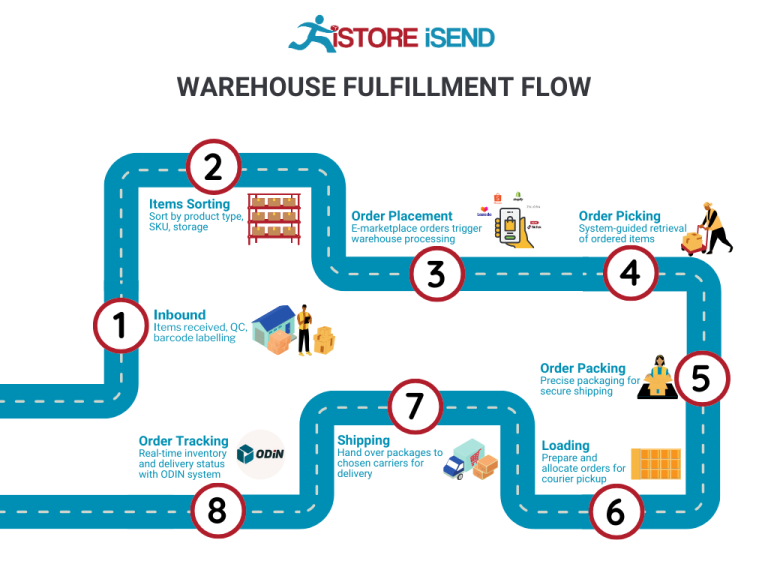
4. Order Packing
After items have been picked, they move on to the packing stage. Here, products are carefully packaged for shipment, ensuring they are protected during transit. This step is important as it not only safeguards the items but also presents an opportunity for branding through packaging design.
A key term in this phase is packing slips, which accompany the order and provide essential information such as order details and return instructions. Effective packing practices contribute to a positive unboxing experience, which can enhance customer satisfaction and loyalty. Moreover, utilizing appropriate packing materials can reduce shipping costs and improve sustainability, aligning with modern consumer preferences.
5. Shipping & Delivery
The final step in the order fulfillment process is shipping and delivery. Once orders are packed, they are labeled and dispatched through various shipping carriers based on customer preferences and service level agreements. Timely delivery is critical for maintaining customer satisfaction and trust.
The term last-mile delivery is particularly relevant here, as it refers to the final leg of the shipping process where the package is delivered from a distribution center to the customer’s doorstep. Effective management of this phase can significantly impact delivery speed and cost. Leveraging technology for route optimization and real-time tracking can enhance transparency and improve the overall customer experience.
In summary, mastering each step of the order fulfillment process is vital for e-commerce businesses looking to scale their operations. By understanding and optimizing these stages—from receiving inventory to final delivery—companies can improve efficiency, enhance customer satisfaction, and ultimately drive growth.
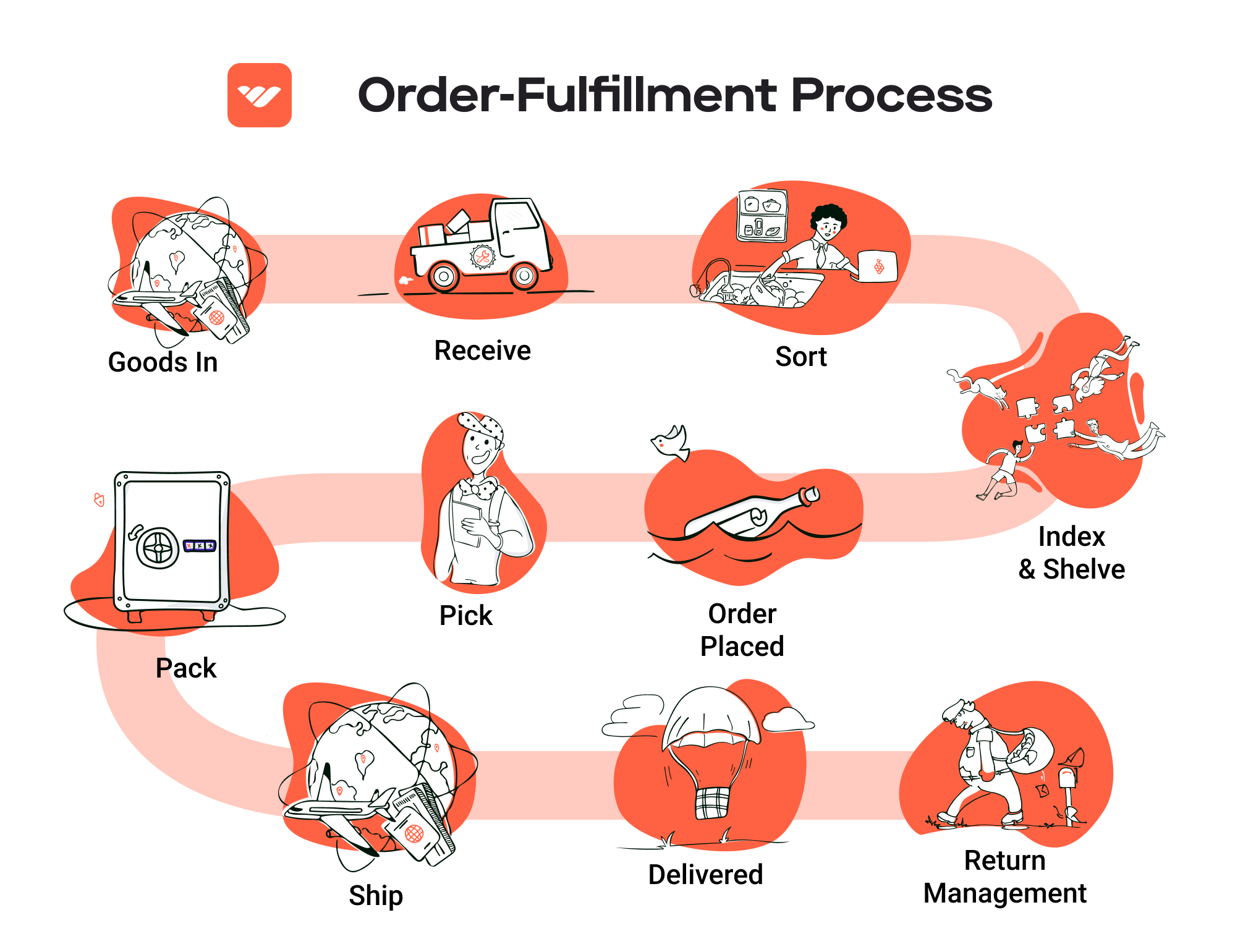
Comparing Fulfillment Models: In-House vs. 3PL vs. Dropshipping
Fulfillment Models Comparison
| Model | Who Handles Inventory | Best For (Business Stage) | Key Advantage | Key Disadvantage |
|---|---|---|---|---|
| In-House Fulfillment | The business itself | Established businesses | Greater control over operations | Higher fixed costs and overhead |
| Third-Party Logistics (3PL) | A third-party provider | Growing businesses | Scalability and reduced overhead | Less control and potential service variability |
| Dropshipping | Supplier or manufacturer | Startups and small businesses | Low startup costs and no inventory risk | Lower profit margins and reliance on suppliers |
In-House Fulfillment
In-house fulfillment means that a business manages its own inventory and order processing. This model is typically adopted by established businesses that have the resources to handle logistics internally. One of the primary advantages of in-house fulfillment is the increased control it offers over the entire process—from inventory management to shipping. Businesses can implement their own quality control measures, customize packaging, and create a tailored customer experience. However, this model comes with significant drawbacks, including higher fixed costs associated with warehousing, staffing, and technology investments. Additionally, as order volumes increase, the complexity of operations can lead to inefficiencies unless carefully managed. Businesses must also be prepared to handle the logistics of returns, which can further complicate in-house operations.
Third-Party Logistics (3PL)
Third-party logistics providers (3PL) take over the logistics and fulfillment processes for businesses. This model is particularly suited for growing businesses that need to scale quickly without the burden of managing warehouse space and logistics. The primary advantage of using a 3PL is the scalability it offers; businesses can easily adjust their fulfillment capabilities in response to fluctuating demand. Additionally, 3PLs often have established relationships with shipping carriers, which can lead to lower shipping rates and faster delivery times. However, relying on a third-party provider does come with challenges. Businesses may experience less control over their inventory and shipping processes, and there can be variability in service levels among different 3PLs. Furthermore, companies must ensure that their 3PL partners align with their brand standards and customer service expectations to avoid potential damage to their reputation.
Dropshipping
Dropshipping is a fulfillment model where businesses sell products without holding inventory. Instead, when a customer places an order, the business purchases the item from a third-party supplier who then ships it directly to the customer. This model is particularly popular among startups and small businesses due to its low entry barriers. One of the significant advantages of dropshipping is that it allows entrepreneurs to start selling without needing to invest in inventory or warehousing upfront. This model also enables businesses to offer a wide range of products without the risks associated with overstocking. However, dropshipping also has its drawbacks. Profit margins can be lower compared to traditional retail models, as suppliers typically charge wholesale prices that leave little room for markup. Moreover, businesses are heavily reliant on their suppliers for inventory management and shipping, which can lead to challenges such as stock shortages, shipping delays, and quality control issues. This dependency can impact customer satisfaction and retention if not managed effectively.
Conclusion
Choosing the right fulfillment model is crucial for scaling an e-commerce business. Each option—In-House Fulfillment, 3PL, and Dropshipping—offers unique advantages and disadvantages, making it essential for business owners to assess their specific needs, resources, and growth objectives. By carefully evaluating these factors, entrepreneurs can select a fulfillment strategy that aligns with their operational capabilities and market demands, ultimately leading to enhanced customer satisfaction and business growth.
A Deep Dive into Amazon FBA: Pros, Cons, and Who It’s For
What is Fulfillment by Amazon (FBA)?
Fulfillment by Amazon (FBA) is a service offered by Amazon that allows sellers to store their products in Amazon’s fulfillment centers. Amazon then takes care of storage, packaging, and shipping of products directly to customers. This service simplifies the logistics of e-commerce, enabling sellers to focus on product sourcing, marketing, and customer engagement while leveraging Amazon’s robust infrastructure.
When a customer orders a product, Amazon handles the entire fulfillment process, including picking the item from the warehouse, packing it, and shipping it to the customer. Moreover, FBA items are eligible for Amazon Prime and other Amazon services, which can significantly enhance product visibility and sales potential.
How Does FBA Work?
-
Product Listing: Sellers create product listings on Amazon and choose which products they want to fulfill through FBA.
-
Inventory Shipment: Sellers prepare their products and ship them to Amazon’s fulfillment centers. It’s essential to follow Amazon’s guidelines for packaging and labeling to ensure smooth processing.
-
Storage: Once the products arrive at the fulfillment center, Amazon stores them until an order is placed.
-
Order Processing: When a customer places an order for an FBA product, Amazon picks, packs, and ships the item.
-
Customer Service: Amazon also handles all customer service inquiries and returns for FBA orders, further relieving sellers of operational burdens.
-
Payment: After an order is fulfilled, Amazon collects payment from the customer and transfers the proceeds to the seller, minus fees.
Pros of Using FBA
-
Prime Eligibility: One of the most significant advantages of FBA is that products become eligible for Amazon Prime, giving sellers access to millions of Prime members who prefer fast, free shipping.
-
Customer Trust: Products fulfilled by Amazon carry the Amazon brand, which is associated with reliability and excellent customer service. This can increase conversion rates as customers feel more secure purchasing from a trusted platform.
-
Multi-Channel Fulfillment: FBA enables sellers to fulfill orders from other sales channels (like their own websites or social media platforms) using Amazon’s infrastructure, streamlining logistics and saving time.
-
Scalability: FBA allows sellers to scale their businesses without the need for extensive warehousing or hiring additional staff. As sales grow, Amazon can handle the increased volume efficiently.
-
Time Savings: With Amazon managing logistics, sellers can focus on marketing, product development, and other critical business areas, rather than day-to-day order fulfillment.
Cons of Using FBA
-
High Fees: FBA charges various fees, including storage fees and fulfillment fees. These costs can add up quickly, especially for sellers with low-margin products or slow-moving inventory.
-
Strict Inventory Rules: Amazon has stringent policies regarding inventory management, including limits on the number of units that can be stored in their warehouses. Non-compliance can lead to additional fees or removal of inventory.
-
Commingling Risks: FBA products may be commingled with inventory from other sellers, which can lead to issues with product quality and misrepresentation. If a customer receives a damaged or defective item from another seller, it may reflect poorly on you, even if your products were not at fault.
-
Loss of Control: By outsourcing fulfillment to Amazon, sellers may lose some control over the customer experience, including packaging and shipping times. Any delays or issues on Amazon’s end can directly impact a seller’s reputation.
-
Complex Returns Process: While Amazon handles returns, the process can be complicated for sellers, especially if they want to maintain control over how returns are processed and restocked.
Who is FBA Best For?
FBA is particularly well-suited for:
-
Small to Medium-Sized Businesses: Businesses that want to scale quickly without investing heavily in logistics infrastructure can benefit greatly from FBA.
-
Sellers with High-Volume Inventory: Businesses that can maintain a fast turnover of inventory can take advantage of FBA’s efficiencies while minimizing storage fees.
-
E-commerce Entrepreneurs: Those who are primarily focused on online sales and marketing rather than logistics and fulfillment will find FBA an attractive option to streamline operations.
-
Brands Seeking Credibility: Newer brands looking to establish credibility and gain customer trust can leverage the Amazon platform to enhance their visibility.
-
Multi-Channel Sellers: Sellers who operate across various platforms (e.g., eBay, their own website) can utilize FBA for streamlined fulfillment, allowing them to manage their orders from a single source.
In conclusion, Fulfillment by Amazon can be a powerful tool for e-commerce businesses looking to scale. While it comes with its set of challenges, the benefits—particularly in terms of customer trust, Prime eligibility, and reduced operational burden—make it an appealing option for many sellers in the online marketplace.
Core Services Offered by Fulfillment Centers
Inventory Management & Warehousing
Effective inventory management is crucial for any e-commerce business aiming to scale operations. Fulfillment centers provide state-of-the-art warehousing solutions that enable businesses to store their products in a secure and organized environment. This service includes tracking stock levels, managing reorders, and optimizing storage space.
Benefits:
1. Real-time Tracking: Fulfillment centers utilize advanced inventory management systems that allow businesses to monitor stock levels in real-time. This reduces the risk of stockouts and overstock situations, which can negatively impact sales and cash flow.
2. Space Optimization: With a professional warehousing solution, businesses can avoid the costs associated with leasing or maintaining their own storage facilities. Fulfillment centers are designed to maximize space efficiency, ensuring products are stored systematically and can be accessed quickly.
3. Scalability: As your business grows, so do your inventory needs. Fulfillment centers can easily adjust to accommodate increased stock, allowing for seamless scaling without the headache of managing additional warehouse space.
Pick and Pack Services
Pick and pack services involve the process of selecting (picking) products from the warehouse and packaging (packing) them for shipment to customers. This is a critical service that directly impacts order fulfillment speed and accuracy.
Benefits:
1. Speed and Efficiency: Fulfillment centers employ trained staff and automated systems to ensure quick and accurate order processing. This leads to faster shipping times, which is essential for customer satisfaction and retention.
2. Accuracy: By utilizing barcode scanning and inventory management software, fulfillment centers minimize errors in order fulfillment. This accuracy reduces the likelihood of returns due to incorrect items being shipped, thereby saving costs and improving customer trust.
3. Custom Packaging Options: Many fulfillment centers offer tailored packaging solutions that align with a brand’s identity. This helps in creating a memorable unboxing experience for customers, enhancing brand loyalty and recognition.
Kitting and Assembly
Kitting and assembly services involve combining multiple products into a single packaged unit or assembling products before they are shipped. This service is particularly useful for businesses that offer bundles, kits, or complex products requiring assembly.
Benefits:
1. Streamlined Operations: By outsourcing kitting and assembly to a fulfillment center, businesses can streamline their operations. This allows them to focus on core activities such as marketing and product development while leaving the complex assembly tasks to the experts.
2. Cost-Effective: Fulfillment centers often have the equipment and workforce necessary to perform kitting and assembly efficiently. This can be more cost-effective than managing these processes in-house, particularly for small to medium-sized businesses.
3. Enhanced Customer Experience: Offering product bundles or pre-assembled items can increase average order value and improve customer satisfaction. Fulfillment centers can help design and manage these offerings, ensuring they are attractive and ready for sale.
Returns Management (Reverse Logistics)
Returns management, or reverse logistics, is the process of handling returned merchandise and integrating it back into inventory. This service is increasingly important in e-commerce, where return rates can be significant, particularly in industries like fashion and electronics.
Benefits:
1. Simplified Returns Process: Fulfillment centers streamline the returns process by providing customers with easy return options and clear instructions. This can lead to higher customer satisfaction and loyalty, as consumers appreciate a hassle-free return experience.
2. Efficient Restocking: Once items are returned, fulfillment centers can quickly assess their condition and determine whether they can be restocked, repaired, or discarded. This efficiency reduces the time products spend out of inventory, helping maintain stock levels.
3. Data Insights: Returns management can also provide valuable insights into customer behavior and product performance. By analyzing return data, businesses can make informed decisions about product quality, customer preferences, and potential areas for improvement.
Conclusion
Utilizing the core services offered by fulfillment centers can significantly enhance an e-commerce business’s efficiency, customer satisfaction, and scalability. From robust inventory management and precise pick and pack services to comprehensive kitting and assembly and effective returns management, fulfillment centers provide the operational backbone that allows businesses to thrive in a competitive market. By leveraging these services, e-commerce entrepreneurs can focus on growth strategies, knowing that their logistics and fulfillment processes are in capable hands.
How to Choose a Fulfillment Partner: A 6-Point Checklist
Location & Warehouse Network
Importance:
The geographical location of your fulfillment partner can significantly impact shipping times, costs, and overall customer satisfaction. A partner with a strategically located warehouse network can ensure faster deliveries to your target markets, reducing transit times and shipping expenses.
Questions to Ask:
– Where are your fulfillment centers located, and how do those locations align with my customer demographics?
– How do you optimize your distribution network for efficient shipping?
– Do you have plans to expand your warehouse network in the future?
Technology & Integrations
Importance:
In today’s e-commerce landscape, having a robust technological backbone is essential. Your fulfillment partner should utilize advanced technology to streamline operations, manage inventory, and integrate seamlessly with your existing e-commerce platforms. This ensures real-time updates and efficient order processing.
Questions to Ask:
– What inventory management systems do you use, and how do they integrate with major e-commerce platforms like Shopify, WooCommerce, or Magento?
– Can you provide real-time tracking information for both orders and inventory?
– How do you handle data security and compliance with regulations like GDPR?
Specializations (e.g., cold storage, oversized items)
Importance:
Not all fulfillment centers are equipped to handle every type of product. If your business deals with specialized goods—such as perishable items requiring cold storage or oversized items—it’s crucial to partner with a fulfillment center that has the necessary infrastructure and expertise.
Questions to Ask:
– Do you offer specialized services such as cold storage or handling of oversized items?
– What certifications or standards do you meet for specialized handling?
– Can you accommodate unique packing or shipping requirements for my products?
Scalability & Capacity
Importance:
As your business grows, your fulfillment needs will evolve. Choosing a partner that can scale with your business is essential to avoid disruptions in service and to manage fluctuating order volumes, especially during peak seasons.
Questions to Ask:
– What is your current capacity, and how do you manage scalability during peak seasons?
– Can you handle sudden spikes in order volume, such as during promotional events or holidays?
– What is your process for onboarding new clients and integrating their products into your system?
Pricing and Contracts
Importance:
Understanding the pricing structure of your fulfillment partner is critical to ensuring that it aligns with your budget and business model. Hidden fees or unexpected costs can erode your profit margins, so transparency in pricing is vital.
Questions to Ask:
– What is your pricing model? Are there any additional fees for services like storage, pick and pack, or returns processing?
– Can you provide a detailed breakdown of your pricing structure?
– What are the contract terms? Is there flexibility for renegotiation as my business grows?
Customer Support & Reviews
Importance:
Effective customer support can make or break your relationship with a fulfillment partner. You need assurance that they will be responsive to your needs and proactive in resolving issues. Additionally, reviewing their track record through customer feedback can provide insights into their reliability and service quality.
Questions to Ask:
– What customer support channels do you offer (e.g., phone, email, live chat), and what are your response times?
– Can you provide references or case studies from clients in my industry?
– How do you handle issues such as order errors or shipping delays? What is your process for communication during these times?
Conclusion
Choosing the right fulfillment partner is a pivotal decision for your e-commerce business. By thoroughly assessing potential partners against these six critical criteria—location and warehouse network, technology and integrations, specializations, scalability and capacity, pricing and contracts, and customer support—you can ensure that you select a partner that not only meets your current needs but also supports your growth in the competitive e-commerce landscape. Prioritize open communication and transparency throughout your discussions to foster a successful partnership that enhances your operational efficiency and customer satisfaction.
Understanding Fulfillment Pricing: A Breakdown of Common Fees
Initial Setup Fees
Initial setup fees are often the first costs a business encounters when partnering with a fulfillment center. These fees typically cover the onboarding process, which includes account setup, integration with e-commerce platforms, and initial inventory assessments. Depending on the complexity of your needs, the fee can vary significantly.
How It’s Calculated:
Initial setup fees can be a flat fee or based on the time and resources required to integrate your systems. Factors influencing this cost include the number of SKUs you need to manage, the complexity of your inventory management requirements, and whether custom software integration is necessary. To minimize these costs, consider preparing your data and ensuring that your e-commerce platform is compatible with the fulfillment center’s systems before initiating the process.
Receiving Fees
Receiving fees are charged when your inventory arrives at the fulfillment center. These fees encompass the labor and resources required to unload, inspect, and stock your products.
How It’s Calculated:
Typically, receiving fees are charged per pallet or per hour of labor. Some centers might have a minimum fee that applies regardless of the shipment size. To optimize costs, consolidate shipments to reduce the frequency of deliveries, or negotiate bulk receiving discounts with your fulfillment provider.
Storage Fees (per pallet/bin)
Storage fees are ongoing costs incurred for keeping your inventory in the fulfillment center. These fees can be calculated on a per-pallet or per-bin basis, depending on how the facility organizes its storage.
How It’s Calculated:
Storage fees are usually billed monthly and can vary based on the size of the pallets or bins your products occupy. Some fulfillment centers also charge based on the volume (cubic feet) of your inventory. To manage these costs effectively, regularly review your inventory levels and consider implementing a just-in-time inventory strategy, which minimizes excess stock and associated storage fees.
Pick & Pack Fees (per item/order)
Pick and pack fees are incurred each time an order is processed. This includes locating the items in the warehouse, packing them, and preparing them for shipment.
How It’s Calculated:
These fees can be charged per item or per order, depending on the fulfillment center’s pricing model. For example, a center may charge a flat fee for the first item and a smaller fee for each additional item in the same order. To reduce pick and pack costs, consider optimizing your product offerings by bundling items or streamlining your inventory to focus on top-selling products.
Shipping Fees
Shipping fees are the costs associated with delivering the packaged orders to your customers. These fees can vary widely based on factors such as shipping method, destination, and package weight.
How It’s Calculated:
Shipping fees are typically calculated based on the carrier’s rates, which consider weight, dimensions, and destination. Fulfillment centers may also charge additional handling fees for special packaging or expedited shipping options. To keep shipping costs manageable, negotiate shipping rates with carriers or consider using a fulfillment center that offers discounted shipping rates as part of their service.
Tips for Getting an Accurate Quote
To receive an accurate quote from a fulfillment center, consider the following steps:
-
Provide Detailed Information: Be clear about your product types, expected order volume, and any special handling requirements. The more details you provide, the more precise the quote will be.
-
Ask About All Fees: Ensure that the quote includes all potential fees, such as storage, receiving, pick and pack, and shipping. Clarifying these costs upfront can prevent surprises later.
-
Evaluate Pricing Models: Different fulfillment centers may use varying pricing models. Compare these models to understand the total cost of ownership and select the most suitable one for your business needs.
-
Negotiate Terms: Don’t hesitate to negotiate terms, especially if you anticipate significant order volumes. Fulfillment centers may offer discounts for long-term commitments or higher volumes.
-
Consider Scalability: Ensure that the pricing structure can accommodate your growth. Discuss any potential changes in fees as your order volume increases to avoid unexpected costs as you scale.
By understanding these common fulfillment pricing models and taking proactive steps to gather accurate quotes, e-commerce business owners can make informed decisions that align with their growth strategies.
Frequently Asked Questions (FAQs) about Fulfillment
1. What is the URBN KC1 Fulfillment Center?
The URBN KC1 Fulfillment Center is a state-of-the-art facility located in Kansas City, Kansas. It is designed for high efficiency and automation in processing and shipping orders for e-commerce businesses. This center allows URBN to fulfill digital orders quickly and effectively, enhancing overall customer satisfaction.
2. How does a fulfillment center differ from a warehouse?
A fulfillment center is specifically designed to process and ship orders directly to customers, focusing on e-commerce operations. In contrast, a warehouse primarily serves as a storage space for inventory without the same level of order processing capabilities. Fulfillment centers often have advanced technology and processes to handle picking, packing, and shipping efficiently.
3. What services does the URBN KC1 Fulfillment Center provide?
The URBN KC1 Fulfillment Center offers a range of services including inventory management, order processing, packaging, and shipping. It is also equipped to handle returns and exchanges, ensuring a seamless experience for both businesses and customers.
4. What is a 3PL (Third-Party Logistics)?
A 3PL is a service provider that manages logistics and supply chain operations for businesses. This can include warehousing, transportation, inventory management, and fulfillment services. Companies often partner with 3PLs to improve efficiency and reduce costs in their logistics operations.
5. How much do fulfillment services cost?
The cost of fulfillment services varies based on several factors, including the volume of orders, types of products, and specific services required (e.g., storage, packaging, shipping). Businesses should expect to pay for storage space, order processing fees, and shipping costs. It’s advisable to request quotes from multiple providers to compare pricing structures.
6. What technology is used in the URBN KC1 Fulfillment Center?
The URBN KC1 Fulfillment Center employs advanced automation technology to enhance efficiency. This includes automated picking systems, inventory management software, and temperature-controlled environments to ensure product quality. The facility’s ergonomic design also contributes to improved worker safety and productivity.
7. How does URBN ensure order accuracy?
URBN implements rigorous quality control measures throughout the fulfillment process. This includes multiple checks at various stages—picking, packing, and shipping—to ensure that orders are accurate. Additionally, the use of technology aids in tracking and managing inventory, reducing the likelihood of errors.
8. Can small businesses use the URBN KC1 Fulfillment Center?
Yes, the URBN KC1 Fulfillment Center is equipped to handle businesses of various sizes, including small businesses. By leveraging URBN’s fulfillment services, smaller e-commerce companies can benefit from efficient logistics without the overhead costs associated with managing their own fulfillment operations.
9. What are the benefits of using a fulfillment center like URBN KC1?
Utilizing a fulfillment center like URBN KC1 can significantly enhance an e-commerce business’s operational efficiency. Benefits include faster shipping times, reduced labor costs, improved inventory management, and access to advanced technology. Additionally, businesses can focus on core activities like marketing and product development while leaving logistics to the experts.
10. How can I get started with URBN’s fulfillment services?
To begin using URBN’s fulfillment services, businesses should reach out directly to URBN’s sales or customer service team through their website. They can provide tailored information based on your specific needs, including pricing, service offerings, and integration processes for your e-commerce platform.
Conclusion: Is Outsourcing Fulfillment the Right Move for Your Business?
Evaluating the Benefits of Outsourcing Fulfillment
Outsourcing fulfillment can be a transformative strategy for e-commerce businesses aiming to scale operations efficiently. By partnering with a specialized fulfillment service, such as the state-of-the-art facilities in Kansas City, businesses can unlock a plethora of benefits.
Time Savings: Managing logistics in-house can be a time-consuming endeavor that diverts attention from core business activities. By outsourcing, you free up valuable resources, allowing your team to focus on marketing, product development, and customer engagement—areas that directly impact growth and profitability.
Scalability: As your business grows, so do your fulfillment needs. A dedicated fulfillment partner can effortlessly scale operations to accommodate fluctuations in order volume, seasonal spikes, and expanding product lines. This flexibility ensures that you can meet customer demands without the burden of overextending your infrastructure or workforce.
Expertise and Efficiency: Fulfillment centers are equipped with advanced technology and skilled personnel who specialize in logistics. By leveraging their expertise, businesses can improve shipping accuracy, reduce delivery times, and enhance overall customer satisfaction. Facilities like URBN’s in Kansas City are designed for optimal performance, which translates to significant cost savings and operational efficiencies for your business.
Choosing the Right Partner for Growth
The decision to outsource fulfillment should not be taken lightly. Selecting the right partner is crucial for ensuring that your logistics operations align with your business goals. Look for a fulfillment center that not only meets your current needs but can also adapt to your future growth.
Call to Action
Now is the perfect time to evaluate your current shipping process. Conduct an audit to identify areas for improvement and determine if partnering with a fulfillment service is the strategic next step for your business. By making informed decisions today, you can position your business for sustainable growth tomorrow.
Important Disclaimer
⚠️ Important Disclaimer
The information in this guide is for educational purposes. Fulfillment services, pricing, and platform features change frequently. Always conduct your own due diligence and consult with providers directly before making business decisions.


